Mars in 2005/6 
The simulations on the right are from
Mr. T. Ikemura and show Mars as it was expected to be seen at the date and time indicated.
I am indebted to Mr. Ikemura for permission to use these images.
Mr. Ikemura's images are shown with north at the top. Most of my images are not exactly
north at the top; generally they are rotated through a small angle.
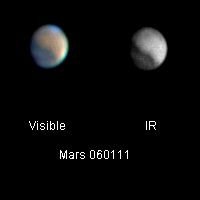
|
And finally (maybe) Mars on the evening of 11th January 2006. Mars was 130.2 million Kilometres (0.870 AU) from the Earth and subtended an angle of only 10 seconds of arc.
Three weeks later and Mars has receded another 30 million kilometres and now subtends only 10 seconds of arc. A very small object but a few surface details are still visible.
Date and Time: 11th January 2006 at 18:15 (vis) and 18:44 (IR) UT
Camera: ToUcam 740K
Telescope: LX200 with X2 lens.
Capture: K3CCDTools.
Visible image: Low gamma, high saturation, 1/25", 20% gain, 625 frames.
IR image: Low gamma, B/W mode, 1/25", 36% gain, 606 frames.
Processing: Registax.
Visible image: 119 frames stacked. Wavelets 1-3 = 10, histogram 20 - 255.
IR image: 111 frames stacked. Wavelets 1-2 = 10, 3 = 5, histogram 20-255.
|
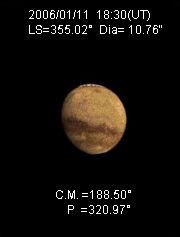
|
|
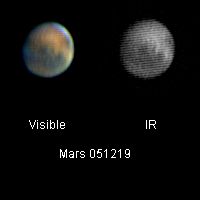
|
Mars on the evening of 19th December 2005. Mars was 101.3 million Kilometres (0.677 AU) from the Earth and subtended an angle of 15 seconds of arc.
Only nine days later than the image below, but now Mars is over a hundred million kilometres away and subtends only 13 seconds of arc.
Date and Time: 19th December 2005 at 20:19 (vis) and 21:30 (IR) UT
Camera: ToUcam 740K
Telescope: LX200 with X2 lens.
Capture: K3CCDTools.
Visible image: Low gamma, high saturation, 1/25", 38% gain, 609 frames.
IR image: Low gamma, B/W mode, 1/25", 93% gain, 617 frames.
Processing: Registax.
Visible image: 132 frames stacked. Wavelets 1-2 = 10, histogram 30 - 200.
IR image: 233 frames stacked. Wavelets 1,3 = 5, 2 = 10, histogram 40-255, gamma 1.3.
|
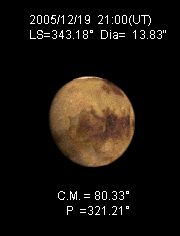
|
|
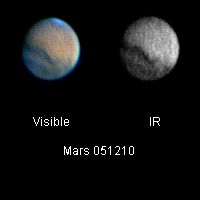
|
Mars on the evening of 10th December 2005. Mars was 91.7 million Kilometres (0.613 AU) from the Earth and subtended an angle of 15 seconds of arc.
Mars is receding from the Earth and so its angular size is decreasing making the surface details more difficult.
Date and Time: 10th December 2005 at 20:46 (vis) and 21:37 (IR) UT
Camera: ToUcam 740K
Telescope: LX200 with X2 lens.
Capture: K3CCDTools.
Visible image: Low gamma, high saturation, 1/25", 55% gain, 708 frames.
IR image: Low gamma, B/W mode, 1/25", 82% gain, 325 frames.
Processing: Registax.
Visible image: 116 frames stacked. Wavelets 1-2 = 10, histogram 50 - 255.
IR image: 94 frames stacked. Wavelets 2-3 = 10, histogram 40-170.
|
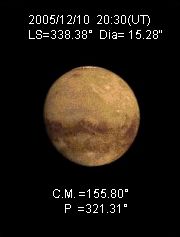
|
|
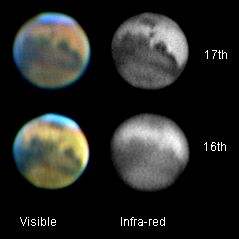
|
Mars on the evenings of 16th and 17th November 2005. Mars was 74.1 million Kilometres (0.496 AU) from the Earth and subtended an angle of 19 seconds of arc.
I have put the pictures from these two days together because I think it is interesting to compare the pictures taken almost exactly 1 day apart. The later (upper) image appears displaced slightly to the west (left) compared to the earlier one. This is because Mars rotates west to east slightly more slowly than the earth does, so a day later we see almost, but not quite exactly, the same side of Mars.
Dates and Times: 17th November 2005 at 21:19 (vis) and 21:08 (IR) UT
16th November 2005 at 21:28 (vis) and 21:35 (IR) UT
Camera: ToUcam 740K
Telescope: LX200 with X2 lens.
Capture: K3CCDTools.
17th: Visible image: Low gamma, high saturation, 1/33", 18% gain, 611 frames.
IR image: Low gamma, B/W mode, 1/25", 31% gain, 603 frames.
16th: Visible image: Low gamma, high saturation, 1/25", 10% gain, 613 frames.
IR image: Low gamma, B/W mode, 1/25", 58% gain, 404 frames.
Processing: Registax.
17th: Visible image: 131 frames stacked. Wavelets 1-3 = 10, histogram 70 - 255.
IR image: 137 frames stacked. Wavelets 1-3 = 10, histogram 30-170.
16th: Visible image: 144 frames stacked. Wavelets 2-3 = 10, histogram 120 - 255.
IR image: 127 frames stacked. Wavelets 2-3 = 10, histogram 50-180.
|
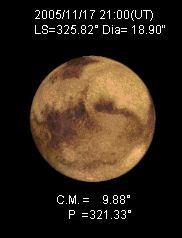
|
|
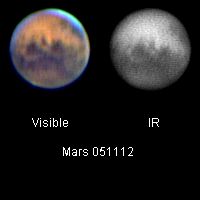
|
Mars on the evening of 12th November 2005. Mars was 72.0 million Kilometres (0.481 AU) from the Earth and subtended an angle of 19.5 seconds of arc.
Although Mars is drawing away for us now, this is one of my best images in visible light, but unfortunately I didn't do the infra-red image until an hour later by which time the seeing had deteriorated significantly.
Date and Time: 12th November 2005 at 21:30 (vis) and 22:21 (IR) UT
Camera: ToUcam 740K
Telescope: LX200 with X2 lens.
Capture: K3CCDTools. Visible image: Low gamma, high saturation, 1/25", 20% gain, 457 frames.
IR image: Low gamma, B/W mode, 1/25", 58% gain, 404 frames.
Processing: Registax. Visible image: 101 frames stacked. Wavelets 1-2 = 10, 3 = 3, histogram 50 - 230. Colours aligned.
IR image: 100 frames stacked. Wavelets 1 = 10, 2 = 5, histogram 30-200.
|
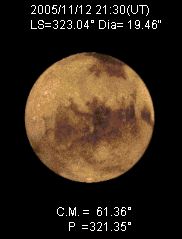
|
|
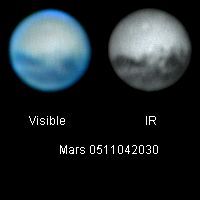
|
Mars on the evening of 4th November 2005. Mars was 69.9 million Kilometres (0.467 AU) from Earth and subtended an angle of 20 seconds of arc.
These pictures were taken only 17 hours after the ones below; that is just under 3/4 of a Martian day, so here we see a different view of the planet. I do believe that the vague white dot near the top of the IR image is Olympus Mons, the largest volcano in the solar system.
Unusually, I captured the IR image here in colour mode, but I adjusted the colour sensitivity of the camera to be as near as I could the same in each channel, so the image appears, as it should, in monochrome.
(I'm not sure what went wrong with the colour picture; it is far too blue for the "red planet".)
Date and Time: 4th November 2005 at 20:44 (vis) and 20:53 (IR) UT
Camera: ToUcam 740K
Telescope: LX200 with X2 lens.
Capture: K3CCDTools. Visible image: Low gamma, high saturation, 1/33", 8% gain, 923 frames.
IR image: Low gamma, high saturation, 1/25", 48% gain, 918 frames.
Processing: Registax. Visible image: 287 frames stacked. Wavelets 1-3 = 10, histogram 30 - 150. Colours aligned.
IR image: 524 frames stacked. Wavelets 1-3 = 10, histogram 20-160.
|
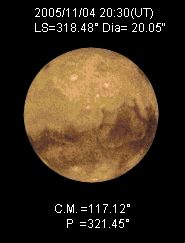
|
|
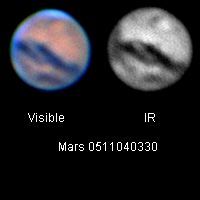
|
Mars on the morning of 4th November 2005. Mars was 69.8 million Kilometres (0.466 AU) from Earth
and subtended an angle of 20 seconds of arc.
I'm rather pleased with these pictures as I was not expecting a clear night that night and awoke to find Mars shining brightly in the south-western sky. Also this is not a good direction for me but Mars was shining through a gap in the trees caused by my neighbour removing an old ash tree recently. So this was all done in rather a rush.
Date and Time: 4th November 2005 at 03:03 (vis) and 03:48 (IR) UT
Camera: ToUcam 740K
Telescope: LX200 with X2 lens.
Capture: K3CCDTools. Visible image: Low gamma, high saturation, 1/50", 35% gain, 946 frames.
IR image: Low gamma, B/W, 1/33", 59% gain, 1007 frames.
Processing: Registax. Visible image: 142 frames stacked. Wavelets 2-4 = 10, histogram 50 - 190. Colours aligned.
IR image: 173 frames stacked. Wavelets 1-3 = 10, histogram 50-160.
|
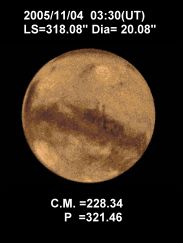
|
|
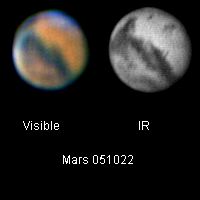
|
Mars on 22nd October 2005. Mars was 70 million Kilometres (0.468 AU) from Earth
and subtended an angle of 20 seconds of arc.
Mars is a strange object for imaging. The conditions were far from perfect; indeed I was not expecting
clear skies that night and the images were made rather quickly before the forecasters became right
(and Mars was rather low in the sky at 30°).
Even so the IR image is one of the best I have ever obtained, and the visible image one of the worst.
The clouds returned before I could try repeating the image in the visible.
Date and Time: 22nd October 2005 at 20:55 (vis) and 21:12 (IR) UT
Camera: ToUcam 740K
Telescope: LX200 with X2 lens.
Capture: K3CCDTools. Visible image: Low gamma, high saturation, 1/33", 16% gain, 637 frames.
IR image: Low gamma, B/W, 1/25", 39% gain, 639 frames.
Processing: Registax. Visible image: 90 frames stacked. Wavelets 2-4 = 10, histogram 50 - 190. Colours aligned.
IR image: 173 frames stacked. Wavelets 1-2 = 10, histogram 16-150.
|
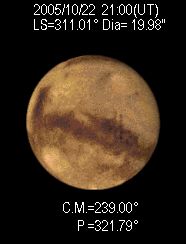
|
|
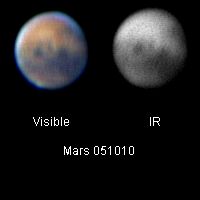
|
Mars on 10th October 2005. Mars was 74 million Kilometres (0.495 AU) from Earth
and subtended an angle of almost 19 seconds of arc.
Mars is getting closer, and brighter. I'm disappointed with these images. I'm
not sure why they are not better. For the coloured image, I balanced the colours during capture just as I did
last time; in this picture I also adjusted the colours slightly in Registax using the sliders, to align
the peaks of the histograms for the three colours. (Click on the image to see what
it looked like before this adjustment, and click again to get back here.)
Date and Time: 10th October 2005 at 01:45 (vis) and 01:55 (IR) UT
Camera: ToUcam 740K
Telescope: LX200 with X2 lens.
Capture: K3CCDTools. Visible image: Low gamma, high saturation, 1/33", 5% gain, 656 frames.
IR image: Low gamma, B/W, 1/25", 33% gain, 716 frames.
Processing: Registax. Visible image: 72 frames stacked. Wavelets 1-3 = 10, histogram 5 - 190. Colours aligned and tweaked slightly.
IR image: 97 frames stacked. Wavelets 1-3 = 10, histogram 10-170.
|
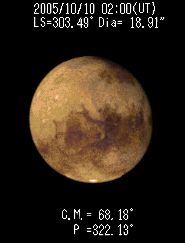
|
|
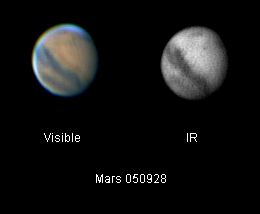
|
Mars on 28th September 2005. Mars was 80 million Kilometres (0.536 AU) from Earth
and subtended an angle of over 17 seconds of arc.
I balanced the colours at the camera by using the RGB version of the brightness meter in K3CCDTools
and adjusting the sliders until the three bars were about equal. I think the
resulting image is a little blue. However the skies were very clear and the exposures are
significantly less than on the previous night.
Date and Time: 28th September 2005 at 02:57 (vis) and 03:03 (IR) UT
Camera: ToUcam 740K
Telescope: LX200 with X2 lens.
Capture: K3CCDTools. Visible image: Low gamma, high saturation, 1/33", 14% gain, 680 frames.
IR image: Low gamma, B/W, 1/25", 39% gain, 612 frames.
Processing: Registax. Visible image: 115 frames stacked. Wavelets 1-2 = 10, contrast 120, brightness -4
IR image: 83 frames stacked. Wavelets 1-2 = 10, 3= 5, histogram 10-170.
|
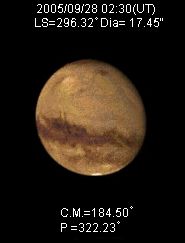
|
|
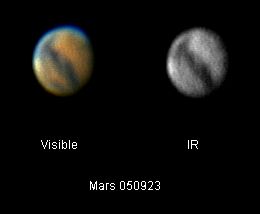
|
Mars on 23rd September 2005. Mars was now 83 million Kilometres (0.557 AU) from Earth
and subtended an angle of almost 17 seconds of arc.
I balanced the colours better here, but the IR image is not as good as usual. I'm not
sure why, but my exposures are longer than they were last time, so I think there must
have been some high cloud in the way.
Date and Time: 23rd September 2005 at 02:54 (vis) and 02:59 (IR) UT
Camera: ToUcam 740K
Telescope: LX200 with X2 lens.
Capture: K3CCDTools. Visible image: Low gamma, high saturation, 1/25", 14% gain, 604 frames.
IR image: Low gamma, B/W, 1/25", 65% gain, 603 frames.
Processing: Registax. Visible image: 91 frames stacked. Wavelets 1-3 = 10, 4 = 5,gamma 0.7, histogram 10-180.
IR image: 133 frames stacked. Wavelets 2-3 = 10, gamma 0.8, histogram 20-180.
|
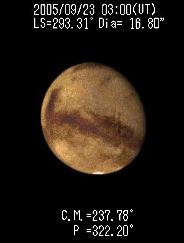
|
|
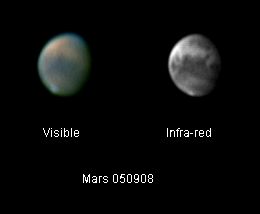
|
Mars on 8th September 2005. Mars was now 94 million Kilometres (0.626 AU) from Earth
and subtended an angle of 15 seconds of arc.
My previous pictures have had no blue content. I have raised the sensitivity of my camera to blue light
for this picture, and maybe there is a little too much. I wonder if this is how Mars
will look if ever man terraforms it. I took pictures with various settings of the
colour sliders in the camera settings and the results may be seen by clicking on this image.
Date and Time: 8th September 2005 at 03:49 (vis) and 03:59 (IR) UT
Camera: ToUcam 740K
Telescope: LX200 with X2 lens.
Capture: K3CCDTools. Visible image: Low gamma, high saturation, 1/50", 12% gain, 637 frames.
IR image: Low gamma, B/W, 1/25", 35% gain, 639 frames.
Processing: Registax. Visible image: 108 frames stacked. Wavelets 1-3 = 10, contrast 160, brightness -10.
IR image: 146 frames stacked. Wavelets 1-3 = 10, contrast 150.
|
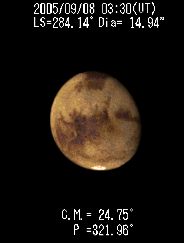
|
|

|
Only two days later, but a better picture. Mars had crept a little closer and was
99 million kilometres (0.666 AU) away from us and subtended an angle of 14 seconds of arc.
The south polar cap is very small but can just be made out. It is high summer in the southern
hemisphere of Mars so the polar cap is expected to be small.
Date and Time: 31st August 2005 at 03:49 (vis) and 03:28 (IR) UT
Camera: ToUcam 740K
Telescope: LX200 with X2 lens.
Capture: K3CCDTools. Visible image: Low gamma, 50% saturation, 1/50", 17% gain, 629 frames.
IR image: Low gamma, B/W, 1/25", 40% gain, 617 frames.
Processing: Registax. Visible image: 115 frames stacked. Wavelets 1-3 = 10, histogram 15-255
IR image: 140 frames stacked. Wavelets 1-4 = 10, histogram 27-255.
|
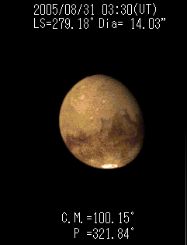
|
|
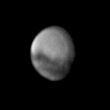
|
Mars continues to get closer. At this time
Mars was 101 million kilometres (0.677 AU) away from us and subtended an angle of 14 seconds of arc.
I only have an IR image; The sky was beginning to lighten and the seeing was not good
so I did not take a colour picture.
Date and Time: 29th August 2005 at 04:18 UT
Camera: ToUcam 740K
Telescope: LX200 with X2 lens and IR-pass filter.
Capture: K3CCDTools. Low gamma, B/W, 1/25", 54% gain, 606 frames.
Processing: Registax. 366 frames stacked. Wavelets 1-5 = 10, gamma 1.3, contrast 130, histogram 40-255.
|
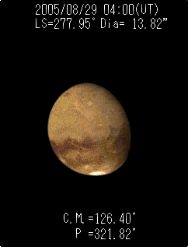
|
|
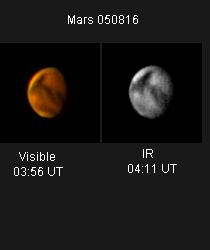
|
Mars at this time was about 84% illuminated, which is almost as small a phase as we ever see.
Mars is getting slowly closer as the Earth catches up with it. At this time
Mars was 114 million kilometres (0.762 AU) away from us and subtended an angle of 12 seconds of arc.
(If the picture is too dark, then move your mouse over the image to see a brighter version.)
Date and Time: 16th August 2005 at times on the picture
Camera: ToUcam 740K
Telescope: LX200 with X2 lens. Visible image with no filters.
Capture: K3CCDTools. Visible image: Low gamma, 50% saturation, 1/50", 13% gain, 304 frames.
IR image: Low gamma, B/W, 1/25", 70% gain, 581 frames.
Processing: Registax. Visible image: 108 frames stacked. Wavelets 1-4 = 10, contrast 155.
IR image: 243 frames stacked. Wavelets 1-4 = 10, contrast 150, histogram 50-255.
|
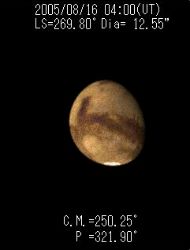
|
|
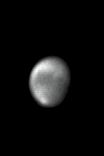
|
Mars on 4th August 2005 was 121 million kilometres (0.781 AU) away from us and subtended an angle of 11 seconds of arc.
This was my first attempt of the new season. There was a lot of high cloud about that morning and by the time I
captured this image the sky was lightening significantly.
I have shrunk Mr. Ikemura's picture to match mine in size.
Date and Time: 4th August 2005 at 03:40 UT
Camera: ToUcam 740K
Telescope: LX200 with X2 lens. IR-pass filter.
Capture: K3CCDTools. Visible image: Low gamma, B/W, 1/25", 51% gain, 1004 frames.
Processing: Registax. 238 frames stacked. Wavelets 1-3 = 10, 4-6 = 5.
|
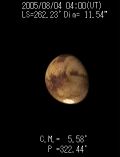
|
Home Back to Mars

